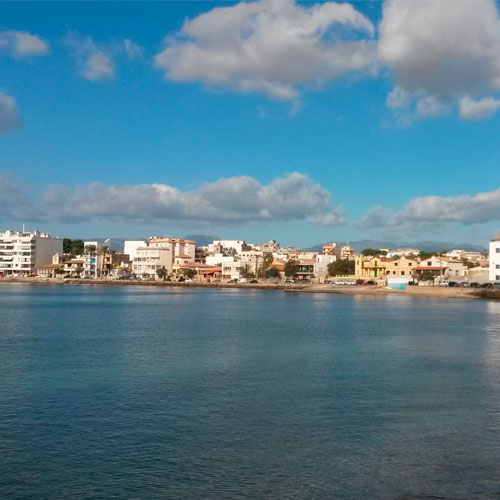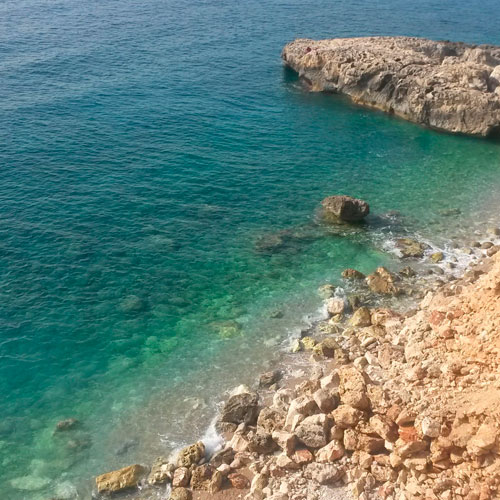Palma-Formentor - Tourism
Palma-Formentor
This excursion offers us two route options: either take the highway that will take us directly to Inca or choose the old road through Santa Maria, Consell and Binissalem instead. We recommend you the latter route, since the trip will be much more pleasant, especially if you decide to make this excursion in January or February. During these two months you will be able to enjoy the almond blossom, a real miracle of nature.
Our first target is Inca. It is the third biggest city within the island, with approximately 25,000 inhabitants and is the capital of the Raiguer area, internationally famous for its high-quality leather goods and shoewear. Do not miss the cellars where huge barrels are being accumulated, called botes congrenyades.
Recommended sightseeing points are the magnificent Santa Maria la Major Church, the Sant Domingo Cloister and the Sant Francesc Church. If you have time, it is worth going up to the Puig de Santa Magdalena, from where you will be able to enjoy a fantastic view over the Pla de Mallorca.
We continue our trip to Alcúdia and just a few kilometres away from Inca, we will find a detour leading us to Campanet. We highly recommend a visit to the Campanet caves.
Now we arrive to Alcúdia. https://www.alcudia.net/. Alcúdia is a medieval city. The city is surrounded by walls and its streets are narrow and irregular.
The most ancient archeological ruins found in Alcúdia belong to the pretalaytoic period (between 2000 and 1200 B.C.). However, it was not until the arrival of the Romans in the year 123 B.C. that the city of Pollentia was founded, located right next to the present city of Alcúdia. Some time later, in the year 902, the Arabs conquered Mallorca and founded the village of Alcúdia. In the year 1298, after the Christian conquest, the walls surrounding the city began to be built. These walls are still visible today. Nowadays, Alcúdia is a typical touristic village. The historic-artistic elements of the city as well as of the archeological area of Pollentia became protected in the year 1963.
Once in Alcúdia you will be able to visit the archeological remains of the Roman city of Pollentia. Nowadays, you will still be able to see the parallel and perpendicular streets, a group of houses, a theatre and the forum, where the public buildings were located. You will also have the chance to visit the Roman theatre that was built in the outskirts of the city, approximately in the Ist century B.C. This theatre still features the remains of its three basic elements; the terraces, the orchestra and the stage. The capacity of the ancient theatre was approximately of 2,500 people. The Monographic Museum of Pollentia displays a small collection of objects that were discovered during archeological excavations in the Roman city of Pollentia. The medieval walls are worth a visit too. King Jaume II gave the order to build these walls. Once in the village centre, we will find the Sant Jaume church, built in the year 1882. The church was built in Gothic style. The church has a single nave with a groined vault.
If you have time, you should visit the Victòria hermitage, just 7 km away from Alcúdia. Here you will find a church in Baroque style that dates back to the XVIIth century. The major altar features a wooden carving from the XVth century, that shows the Mare de Déu de la Victòria. From the hermitage we will have the chance to do several excursions by foot or take a swim in one of its beautiful beaches.
The Albufera, a humid area located in the bay of Alcúdia, was the first natural park of the Balearic Islands. The Albufera offers the visitor more than 230 bird species. Hence, it is a very special place for bird lovers and friends of ornithology.
After a stroll along the Albufera, we will head to the village of Pollença (https://www.ajpollenca.net/). Archeological findings have been discovered in both Pollença and Alcúdia that prove human settlements during prehistoric times. Later on in time, Pollença was a city that suffered frequet invasions, due to its geographic location and its strategic position as an island.
Every year, in the month of August, the inhabitants of Pollença celebrate the Festivity of Moors and Christians in commemoration of that time period.
Nowadays, Pollença, such as most villages on the island, lives from tourism. The first hotel within the municipality, the Hotel Formentor, is a touristic symbol of the Balearic Islands. The hotel first opened its doors in the year 1928 and still is one of the best and most emblematic hotels of Mallorca.
Even though the most important source of income is tourism, we can still find plenty of handicraft workshops where ceramics and fabrics are being made by hand.
Once in the village it might be specially interesting to visit the Municipal Museum, located in the Sant Domingo Convent. This convent was built in the XVIth century and displays objects of ancient times. The convent is the venue for the famous Festival de Pollença that is being celebrated every year (https://www.festivalpollenca.org/). The convent has a collection of pots from the XVIIth century, paintings from the XIXth century as well as archeological remains. We recommend a visit to the church of Nostra Senyora del Roser as well. There we will be able to admire a Baroque altarpiece from the year 1651 as well as a beautiful Baroque organ built in the year 1732.
Interestingly, Pollença is the only place in Mallorca where we will find a Roman bridge. This bridge became a historic-artistic monument.
Furthermore, we recommend a visit to the Calvari, located on a small hill, as well as the Puig de Maria sanctuary, from where we will be able to enjoy an amazing view over the bays of Alcúdia and Pollença.
Our next stop will be Port de Pollença, an ancient fishing village. Even though it became a major touristic centre a couple of years ago, it still mainatains the special atmosphere that characterises ancient fishing villages.
Finally, we will head to Formentor, one of the internationally best-known beaches. However, before reaching Formentor, let us make a brief stop at the viewpoint, one of the most visited places on the island due to the magnificent view over the cliffs and the mountains of the Tramuntana range. Should you have some spare time, you may wish to visit the Formentor lighthouse, approximately 10 km away from the beach.
The tour can be made by car, by participating at an excursion organised by a travel agency or, if you choose to travel by public transport, by taking the bus. In case you choose to use the public transport, please visit the menu "Transport on the island" on this website.
Duration of the excursion: All day, including the breaks
Total distance covered: 162.4 km
from which:
Palma-Inca, 31.1 km
Inca- Alcúdia, 24.9 km
Alcúdia-Pollença, 11 km
Pollença-Formentor, 14.2 km
Formentor- Palma, 81.2 km
Date last modified: March 13, 2023



















